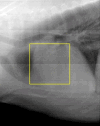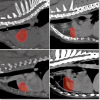Retrospective Study Evaluating Outcomes Following Palliative Radiotherapy With or Without Chemotherapy for Dogs With Presumed Cardiac Hemangiosarcoma
- PMID: 40443234
- PMCID: PMC12378083
- DOI: 10.1111/vco.13068
Retrospective Study Evaluating Outcomes Following Palliative Radiotherapy With or Without Chemotherapy for Dogs With Presumed Cardiac Hemangiosarcoma
Abstract
Canine cardiac hemangiosarcoma (cHSA) represents a complex clinical challenge in that those afflicted have an acute risk of death due to cardiac tamponade and high morbidity and mortality given the frequency of metastasis. Previous studies show that radiation therapy (RT) can decrease the risk of tamponade; however, an optimal approach has yet to be determined. The objective of this study was to evaluate the outcomes of dogs with presumptive cHSA treated with varied RT protocols and modalities, and to contrast findings with previously published literature. Secondary objectives were to assess differences in outcomes between those that received chemotherapy post-RT or did not, single fraction versus multiple-fraction RT protocols, and CT-guided versus manually calculated treatment plans. Twenty-seven dogs with echocardiographic evidence of an atrial or auricular cardiac mass that received RT were included. The frequency of pericardiocentesis before and post-RT were compared. Overall survival time was determined, along with survival time specific to those that received chemotherapy, were treated with CT-based radiation plans, and were prescribed a single fraction versus multiple fractions. Pericardiocentesis was performed an average of 1.1 times per week before RT, and an average of 0.18 times per week after RT (p = 0.01). Median overall survival time was 137 days. Plans made without CT guidance were associated with more adverse radiation events, but all were minimally impactful on quality of life. Most dogs died or were euthanized due to metastatic disease. This study shows similar benefits to previously published data in a larger cohort of dogs using a less-conformal radiation modality. As well, it highlights future directions to identify optimal systemic therapies to delay the onset of metastasis.
Keywords: hemangiosarcoma; pericardial effusion; pericardiocentesis; radiotherapy.
© 2025 The Author(s). Veterinary and Comparative Oncology published by John Wiley & Sons Ltd.
Conflict of interest statement
The authors declare no conflicts of interest.
Figures




References
-
- Waters D. J., Caywood D. D., Hayden D. W., and Klausner J. S., “Metastatic Pattern in Dogs With Splenic Haemangiosarcoma: Clinical Implications,” Journal of Small Animal Practice 29, no. 12 (1988): 805–814.
-
- Boston S. E., Higginson G., and Monteith G., “Concurrent Splenic and Right Atrial Mass at Presentation in Dogs With HSA: A Retrospective Study,” Journal of the American Veterinary Medical Association 47, no. 5 (2011): 336–341. - PubMed
-
- Aronsohn M., “Cardiac Hemangiosarcoma in the Dog: A Review of 38 Cases,” Journal of the American Veterinary Medical Association 187, no. 9 (1985): 922–926. - PubMed
-
- Ware W. A. and Hopper D. L., “Cardiac Tumors in Dogs: 1982–1995,” Journal of Veterinary Internal Medicine 13, no. 2 (1999): 95–103. - PubMed
-
- Treggiari E., Pedro B., Dukes‐McEwan J., Gelzer A. R., and Blackwood L., “A Descriptive Review of Cardiac Tumours in Dogs and Cats,” Veterinary and Comparative Oncology 15, no. 2 (2017): 273–288. - PubMed
MeSH terms
Substances
LinkOut - more resources
Full Text Sources
Research Materials

